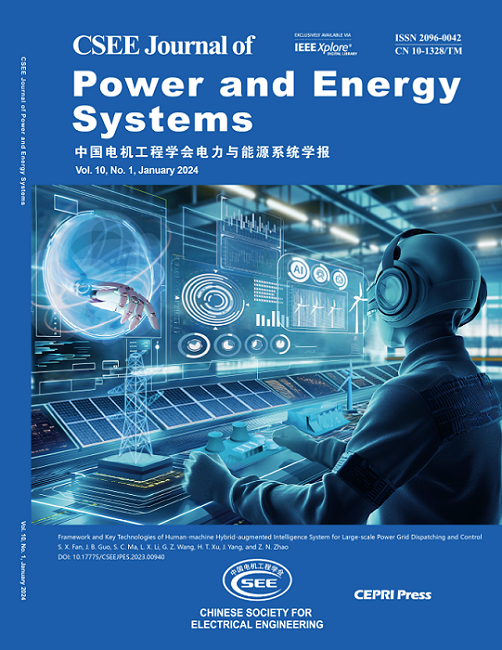采用新型耗散电阻拓扑结构的直流电网故障电流协调抑制方法
IF 5.9
2区 工程技术
Q2 ENERGY & FUELS
引用次数: 0
摘要
基于半桥模块化多电平变换器(HB-MMC)的直流电网是实现可再生能源友好并网的可行手段。针对直流断路器成本高、技术难度大等问题,提出了一种用于风力发电直流电网故障电流抑制的协调控制方法。通过故障特征分析,揭示了直流故障电流的关键影响因素,提出了一种MMC自适应限流控制方法,设计了其参数选择原则,在保证设备安全运行的同时,实现了对故障电流的有效抑制。此外,提出了一种具有限流功能的新型耗散电阻配置方法,既能解决直流电网的剩余功率问题,又能减小换流阀的电流应力。在此基础上,提出了一种耗散电阻协调方案、自适应限流控制方法和DCCB来阻断故障电流,有效降低了DCCB的制造难度和成本。最后,基于RTLAB OP5600实时数字仿真平台建立了四端直流电网仿真模型,验证了所提方法的有效性和可行性。本文章由计算机程序翻译,如有差异,请以英文原文为准。
Coordinated Suppression Method of Fault Current for DC Grid with Novel Dissipative Resistors Topology
A DC grid based on half-bridge modular multilevel converters (HB-MMC) is a feasible means to realize the friendly grid connection of renewable energy. To solve problems such as the high cost and technical difficulty of DC circuit breakers (DCCB), a coordinated control method for fault current suppression of DC grid connecting wind power is proposed. The key influencing factors of DC fault current are revealed by fault characteristics analysis, and an adaptive current-limiting control method for MMC is proposed, whose parameter selection principles are designed to ensure the safe operation of equipment while achieving effective suppression of fault current. In addition, a novel configuration method of dissipative resistors with the current-limiting function is proposed, which can solve the problem of surplus power in the DC grid and reduce the current stress of converter valves. Based on this, a coordination scheme of dissipative resistors, the adaptive current-limiting control method, and DCCBs are proposed to block fault current, effectively reducing the manufacturing difficulty and cost of DCCB. Finally, a four-terminal DC grid simulation model is built based on the RTLAB OP5600 real-time digital simulation platform, and the effectiveness and feasibility of the proposed methods are verified.
求助全文
通过发布文献求助,成功后即可免费获取论文全文。
去求助
来源期刊

CSEE Journal of Power and Energy Systems
Energy-Energy (all)
CiteScore
11.80
自引率
12.70%
发文量
389
审稿时长
26 weeks
期刊介绍:
The CSEE Journal of Power and Energy Systems (JPES) is an international bimonthly journal published by the Chinese Society for Electrical Engineering (CSEE) in collaboration with CEPRI (China Electric Power Research Institute) and IEEE (The Institute of Electrical and Electronics Engineers) Inc. Indexed by SCI, Scopus, INSPEC, CSAD (Chinese Science Abstracts Database), DOAJ, and ProQuest, it serves as a platform for reporting cutting-edge theories, methods, technologies, and applications shaping the development of power systems in energy transition. The journal offers authors an international platform to enhance the reach and impact of their contributions.
 求助内容:
求助内容: 应助结果提醒方式:
应助结果提醒方式:


